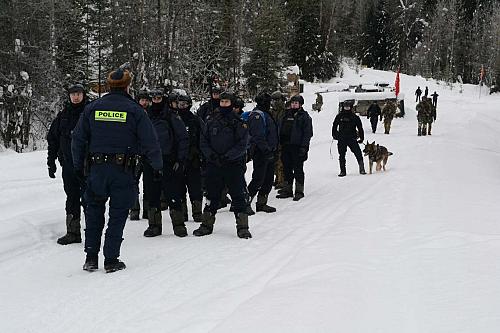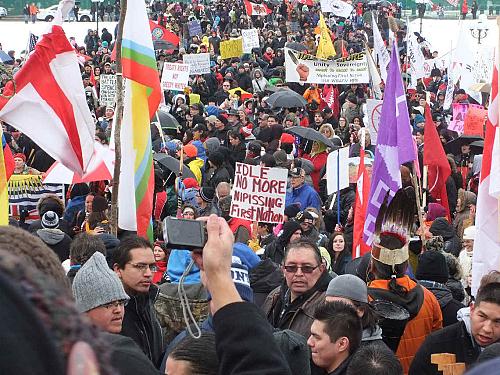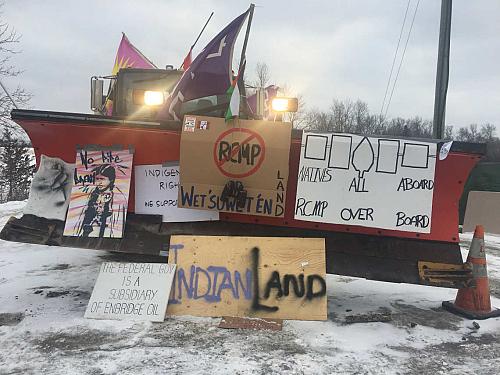The year 2020 in Canada was monumental for Indigenous resistance and police repression. High profile conflicts between settlers and Indigenous peoples over land and resources continue to materialize, from the forced removal of Wet’suwet’en land defenders blocking pipeline construction on the west coast to a violent backlash to a Mi’kmaw fishery in the east coast, to an ongoing land reclamation struggle in central Canada. Indigenous solidarity actions organized under the hashtag “Shut Down Canada” have also disrupted the Canadian economy and led to multiple arrests and criminal charges. This article discusses how policing, surveillance, and criminalization are used as tools of the settler-colonial state to assert and maintain control over Indigenous lands. While focusing on policing tactics and strategies uncovered through access to information requests, the article also highlights the use of the blockade as an anti-colonial tactic and emphasizes the strength and resolve of Indigenous resistance.
For over 500 years, Indigenous peoples in what is now called Canada have resisted European encroachment and settlement on their lands. Before European contact, the lands of Turtle Island (present-day Canada, the United States, and Mexico) were home to dozens of Indigenous nations and millions of inhabitants. Colonialism brought disease, war, a racial sense of superiority, and foreign systems of governance, law, and private property. Indigenous nations fought against and alongside European powers and forged numerous treaties across these lands. The two-row wampum belt signifies the essence of early treaty-making where each purple row represents a path: one for Indigenous peoples and one for Europeans where the two peoples can co-exist peacefully as long as one does not impose themselves on or interfere with the other. Unfortunately, this and other treaties have not been honoured as the Canadian state and its predecessors have attempted to subjugate, assimilate, and eliminate Indigenous peoples for the purpose of accessing and profiting from Indigenous lands and resources.
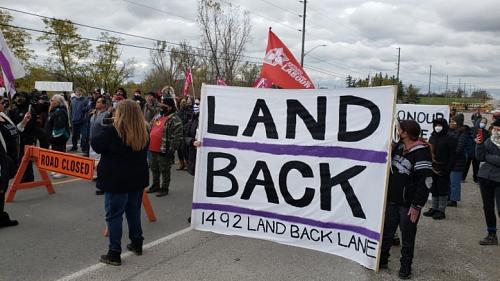
Canada is a relatively young nation-state, having celebrated its 150th birthday in 2017. The official founding of Canada with the 1867 British North America Act sought to incorporate Indigenous lands and resources under the jurisdiction of the provinces and territories of the newly minted federation. The Act imposed and instilled a British-style system of parliamentary democracy, law, and private property that not only excluded Indigenous peoples, but attempted to eliminate them from their lands through a systematic approach to cultural genocide that has been well-documented. The most well-known examples are the reserve system and residential schools which sought to remove Indigenous peoples from their lands and “kill the Indian in the child.” These approaches and numerous others were implemented in Canadian law through the Indian Act (1876) still in force today, with the last residential school closing in 1996.
Indigenous peoples have always resisted settler colonialism and the theft of their lands, from the expansion of the Canadian state and settlement in the west to present-day conflicts over land and resources. Indigenous peoples asserting self-determination and sovereign jurisdiction over their territories and resisting settler access to their lands have been met with repression, surveillance, and criminalization. From the execution of First Nations and Métis leaders in the early battles over the plains to the imprisonment of modern-day Indigenous warriors, the criminal justice system is widely viewed as a perpetuating instrument of oppression and colonization.
Organized Indigenous activism intensified in the 1960s through to the 1980s with the blockade increasingly used as a tactic to assert Indigenous territorial authority and prevent unauthorized access to their lands. In 1990, the conflict near Oka, Québec on the Mohawk lands of Kanehsatake (often referred to as “the Oka Crisis”), signalled an intensification of police surveillance and repression of Indigenous activism. The armed standoff between Mohawk warriors and the Sûreté du Québec provincial police and Canadian military in 1990 materialized over the expansion of a golf course on sacred Mohawk lands. State violence also erupted in 1995 in the provinces of British Columbia and Ontario following Indigenous land reclamations at Ts’Peten (Gustafsen Lake) and Ipperwash, where an unarmed Indigenous man was shot and killed by Ontario Provincial Police. Settler violence has also targeted Mi’kmaw fishers in New Brunswick (1999) and Nova Scotia (2020), Six Nations land defenders resisting suburban real estate expansion in southern Ontario (2006 and 2020), Mi’kmaw water protectors attempting to stop shale gas exploration in southeastern New Brunswick (2013), and various Indigenous nations (Gitxsan, Secwépemc, Wet’suwet’en) resisting oil and gas pipeline expansion in British Columbia in recent years. While these instances have made international headlines due to the use of police force, there are numerous other recent examples of police surveillance targeting Indigenous opposition to extractive industries and government policies, as revealed in access to information requests.
The Idle No More movement involving dozens of Indigenous communities and thousands of activists in 2012-2013 was met with potentially the largest surveillance operation and mobilization of national security resources in Canada’s history. The Royal Canadian Mounted Police (RCMP) monitored and documented upwards of 1,000 events in a national uprising that included everything from teach-ins and round-dances to blockades of roads, rails, ports, and border crossings. During Idle No More, police on the ground meticulously tracked protests and participants while the national security apparatus framed the movement in terms of “domestic extremism.” Idle No More prompted security officials to consider creating a “central fusion centre for Native problems.”
Canada is one of the richest countries in the world, deriving much of its wealth from natural resources. Canada’s economy is resource-based and driven by the logics of extractive capitalism, with lucrative oil, gas, mining, forestry, fishing, and hydro-electric industries—sectors which have deeply impacted Indigenous lands and lives. Ambitions to turn Canada into a global energy superpower have accelerated conflict with Indigenous peoples defending their lands and waters. In recent years, internal government records obtained through access to information requests have shown the development and depth of the symbiotic relationship between industry and police collaborating to stifle Indigenous dissent and facilitate the exploitation of Indigenous lands and resources. The role of police as an enforcement arm of the extractive industries is increasingly documented across multiple territories and sectors, in particular the RCMP (which has a long history of enforcing Canada’s Indian Act and policy of eliminating and displacing Indigenous peoples from their lands). Internal government records reveal how the RCMP work closely with resource extraction companies to devise security and policing plans so that work can be carried out unhindered, as well as identify, surveil, and criminalize opponents. Indigenous opponents have been labelled as “violent Aboriginal extremists,” and “Aboriginal extremism” has emerged as a threat category in counter-terrorism assessments compiled by the Canadian Security Intelligence Service and its Integrated Terrorism Assessment Centre.
The central concern of Canadian authorities is two-fold. First, Indigenous movements and mobilizations for self-determination pose a threat to the idea and legitimacy of Canada and, second, that Indigenous blockades and protests pose a threat to the economic security of Canada. First, government authorities and security officials dismiss Indigenous demands for self-determination as “perceived grievances” and “sovereignty concerns” that are made by “factions” and “splinter groups.” Indigenous jurisdiction, law, and treaty rights are subverted under the authority of Canadian law, assertion of Crown sovereignty, and claimed ownership of Indigenous lands. Second, Indigenous resistance to resource development impedes the extraction of wealth from Indigenous lands that feeds the prosperity of settler society. This idea of the “ransom economy”—that Indigenous peoples are holding Canada hostage—impacting Canada’s economic security is increasingly framed by counter-terrorism and national security agencies as threatening “critical infrastructure.”
Following a police raid of a Wet’suwet’en checkpoint in 2019, an RCMP sergeant wrote in a signed affidavit that “critical infrastructure can be targeted by persons with radicalized ideology.” The “radicalized ideology” refers to the Wet’suwet’en position that they have never surrendered or ceded their land, that consent is required to enter their territory, and that neither British Columbia nor Canada have jurisdictional authority over their land. This is one frame in which Indigenous movements, communities, and peoples are policed, surveilled, and criminalized—that Indigenous assertions of sovereignty are nothing more than concerns or grievances. This goes hand in hand with another frame referenced by the RCMP sergeant, that Indigenous blockades and protests are seen as targeting and threatening “critical infrastructure”, which represents the vital systems and networks that enrich and sustain settler society. In 2007, the RCMP Criminal Intelligence unit created an Aboriginal Joint Intelligence Group (JIG) to develop a “national approach to Aboriginal disturbances” that was primarily interested in “tension against critical infrastructure.” At the time the JIG produced an annual “Aboriginal Communities of Concern” report that profiled Indigenous communities with a history of resistance that were in close proximity and could potentially threaten critical infrastructure. These reports reveal the close relationship that security agencies forged with the private sector in attempting to mitigate perceived threats to the energy and transportation sectors.
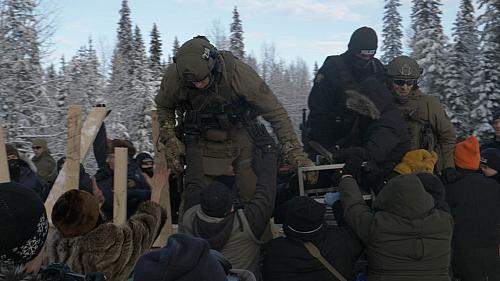
While researching the book Policing Indigenous Movements: Dissent and the Security State—which primarily uses internal records obtained through access to information requests—I obtained a copy of a police report that sheds light on the depth of surveillance targeting Indigenous activists. The 2015 report—Project SITKA: Serious Criminality Associated to Large Public Order Events with National Implications—was published by the RCMP’s National Intelligence Coordination Centre as part of a concerted effort to identify and mitigate the “threat, incidence and prevalence of serious criminality associated to Aboriginal public order events.” The report was primarily concerned with identifying threats to “natural resource development, particularly pipeline and shale gas expansion,” and targeted 313 activists. Of the 313, SITKA investigators identified 89 individuals that matched the project’s “criteria for criminality” and were classified as either “disruptive” or “volatile” based on a surveillance and risk assessment of their “background, motivation and rhetoric.” The profiles were uploaded into criminal intelligence and police reporting databases and made available both to frontline officers and to law enforcement partners. Project SITKA made national headlines at the time it was released to media, as it exposes the tactics and tools of surveillance and criminalization deployed by national security agencies against Indigenous peoples protecting their lands. The surveillance efforts and release of this information prompted strong backlash from Indigenous activists.
A webinar was held in December 2020 with prominent Indigenous activists, at least two of which have been identified in Project SITKA. All of the webinar panelists had been arrested and experienced criminalization. This past year has featured some high-profile incidents and police operations. These include a crackdown on the Tiny House Warriors of the Secwépemc nation and their efforts to stop the Government of Canada-owned Trans Mountain expansion pipeline in British Columbia, an Ontario Provincial Police attack against a land reclamation site at Six Nations of the Grand River in southern Ontario, and a large RCMP raid and forced removal of Wet’suwet’en from their lands in British Columbia. Heavily armed raids on the Gidimt’en checkpoint and Unist’ot’en camp led by the RCMP’s militarized Emergency Response Team was the culmination of over ten years of Wet’suwet’en resistance to various pipeline projects slated for construction on their territory. Molly Wickham of the Gidimt’en clan of the Wet’suwet’en nation noted during the webinar that her people experience surveillance on a daily basis, criminalization just for being an Indigenous person and existing on their land, as well as “extreme violence from militarized RCMP and the state.”
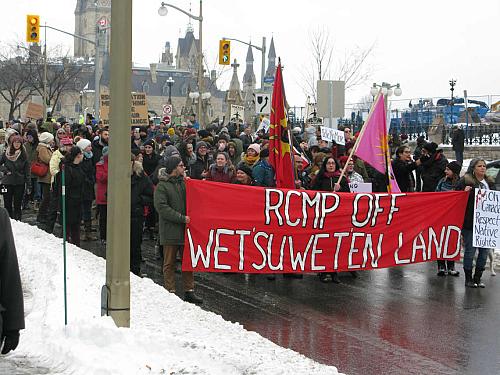
Following the RCMP raid on and occupation of Wet’suwet’en land, Indigenous communities across Canada blockaded roads and railways on their territories in solidarity. Indigenous communities have a long history of supporting each other when one comes under attack, going back to “the Oka Crisis.” In February 2020, Mohawks at Tyendinaga in southeastern Ontario blockaded a major railway for almost one month, incapacitating rail traffic in one of the busiest transportation corridors in Canada. The Ontario Provincial Police eventually moved in with a large force to end the blockade. Some sixty people are facing serious criminal charges from police raids on Indigenous lands and solidarity actions in 2020. Indigenous activists at these sites spoke of intense and constant surveillance by police and industry security forces. They see these efforts as a concerted attempt to forcibly remove and eliminate Indigenous peoples from their homelands in order to access resources and wealth for the ongoing enrichment of Canadian settler society; this is the essence of the settler colonial project in Canada.
The intended impact of police repression, surveillance, and criminalization is to have a chilling effect on Indigenous land defense efforts and solidarity actions. The actual impact, however, has been to strengthen the resolve of Indigenous land defenders. The year 2020 is evidence of that. The focus of the December 2020 webinar was the “ransom economy” that, when Indigenous peoples erect blockades on their land, mainstream settler society decries that the Canadian economy is being held hostage. Activists have turned this idea on its head, that Indigenous lands are being held hostage by Canada. As Mi’kmaw warrior Suzanne Patles framed it during the webinar: “Indigenous sovereignty and title are a threat to the privatization of land, and that land has been held ransom against our people since the British North America Act.” Patles views the blockade as an important defensive strategy, noting that “blockades are the seeds of our self-determination as a people.”
The blockade tactic has been used for decades now, but it has been used with increased frequency as part of a counter-strategy to prevent unauthorized access to Indigenous lands, to disrupt the Canadian economy, and to signal to investors that it is risky to do business due to Canada’s fragile claim of ownership over Indigenous lands and resources. According to Kanahus Manuel of the Secwépemc nation and Tiny House Warriors, “Blockades are a place where Indigenous sovereignty and jurisdictional and territorial authority will confront the assumed colonial authority and jurisdiction. They think they own the land, we know we own the land, and the blockade is where we meet.” To dismantle blockades extractive industries, government, and police rely on a legal mechanism known as a court injunction. Referred to by the late Indigenous leader Arthur Manuel as Canada’s “legal billy club,” the injunction provides legal justification and authorization for police use of force to arrest and remove Indigenous peoples from their lands and lay criminal charges and restrictive conditions.
Despite experiencing a concerted effort of police repression and criminalization, Indigenous resolve is steadfast and determined. Yet, while land defense efforts intensify, so do policing efforts, including new surveillance mechanisms and instruments of repression. For example, the RCMP recently created the Community-Industry Response Group, which works closely with energy companies to surveil and harass Indigenous peoples on their land. Canada is a small country in terms of population and international stature, yet the Canadian state’s approach to Indigenous relations and policing Indigenous peoples is significant to understanding the manifestations and operations of settler colonialism in an unsettled question and battle over land in the 21st Century.
Bibliography and further references :
- Béchard, Deni Ellis et Natasha Kanapé Fontaine. 2021. Kuei, je te salue : Conversation sur le racisme. Montréal : Écosocieté.
- Bibeau, Gilles. 2020. Les Autochtones : La part effacée du Québec. Montréal : Mémoire D’encrier.
- Commission royale sur les peuples autochtones. 1996.Rapport de la Commission royale sur les peuples autochtones. Ottawa: Groupe des Communications du Canada.
- Commission de vérité et réconciliation. 2015. Rapport final de la Commission de vérité et réconciliation du Canada, Volume 6. Montréal & Kingston: McGill-Queen’s University Press.
- Antane Kapesh, An. 2019. Je suis une maudite sauvagesse. Eukuan nin matshi-manitu innushk. Montréal : Mémoire D’encrier.
- Antane Kapesh, An. 2020. Qu’as-tu fait de mon pays ? Tanite nan etutamin nitassi ? Montréal : Mémoire D’encrier.
- Manuel, Arthur. 2018. Décoloniser le Canada : 50 ans de militantisme autochtone. Montréal : Écosocieté.
- Nungak, Zebedee. 2019. Contre le colonialisme dopé aux stéroïdes : le combat des Inuits. Montréal : Boréal.
=================================================================
- Anaya, James. 2014. “Report of the Special Rapporteur on the Rights of Indigenous Peoples, James Anaya, on the Situation of Indigenous peoples in Canada.” United Nations. Human Rights Council, 27th session, May.
- Asch, Michael. 2014. On Being Here to Stay: Treaties and Aboriginal Rights in Canada. Toronto: University of Toronto Press.
- Battell Lowman, Emma, and Adam Barker. 2016. Settler: Identity and Colonialism in 21st Century Canada. Halifax: Fernwood Publishing.
- Benvenuto, Jeff, Andrew Woolford, and Alexander Laban Hinton, eds. 2015. Colonial Genocide in Indigenous North America. Durham: Duke University Press.
- Coulthard, Glen. 2014. Red Skin, White Masks: Rejecting the Colonial Politics of Recognition. Minneapolis: University of Minnesota Press.
- Hill, Gord. 2010. 500 Years of Indigenous Resistance. Oakland: PM Press.
- The Kino-nda-niimi Collective, eds. 2014. The Winter We Danced: Voices from the Past, the Future, and the Idle No More Movement. Winnipeg: ARP Books.
- Manuel, Arthur. 2015. Unsettling Canada: A National Wake-Up Call. Toronto: Between the Lines.
- Manuel, Arthur. 2017. The Reconciliation Manifesto: Recovering the Land, Rebuilding the Economy. Toronto: James Lorimer & Company.
- Niezen, Ronald. 2017. Truth and Indignation: Canada’s Truth and Reconciliation Commission on Indian Residential Schools. University of Toronto Press.
- Palmater, Pamela. 2015. Indigenous Nationhood: Empowering Grassroots Citizens. Halifax and Winnipeg: Fernwood Publishing.
- Palmater, Pamela. 2020. Warrior Life: Indigenous Resistance & Resurgence. Halifax & Winnipeg: Fernwood Publishing.
- Regan, Paulette. 2010. Unsettling the Settler Within: Indian Residential Schools, Truth Telling, and Reconciliation in Canada. Vancouver: University of British Columbia Press.
- RCAP (Royal Commission on Aboriginal Peoples). 1996. Final Report of the Royal Commission on Aboriginal Peoples. Ottawa: Canada Communications Group.
- Simpson, Audra. 2014. Mohawk Interruptus: Political Life Across the Borders of Settler States. Durham: Duke University Press.
- Stote, Karen. 2015. An Act of Genocide: Colonialism and the Sterilization of Aboriginal Women. Halifax & Winnipeg: Fernwood Publishing.
- Truth, and Reconciliation Commission of Canada. 2015. Canada’s Residential Schools: The Final Report of the Truth and Reconciliation Commission of Canada. Vol. 1. Montréal & Kingston: McGill-Queen’s University Press.

